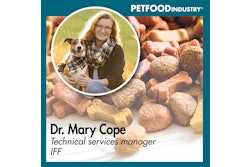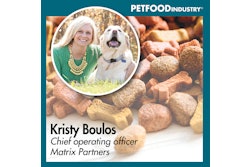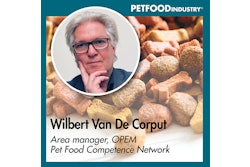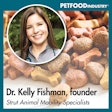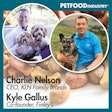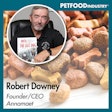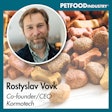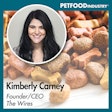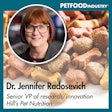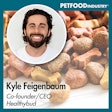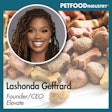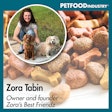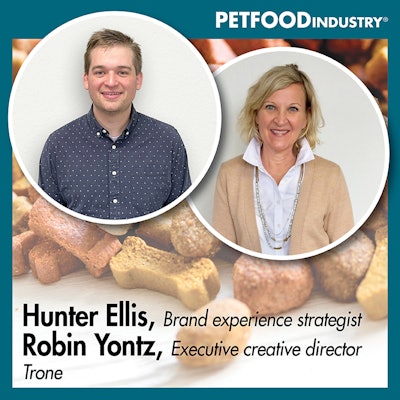
In this episode of the Trending: Pet Food podcast, Lindsay Beaton, editor of Petfood Industry magazine, discusses the rise of private-label pet food brands with guests Hunter Ellis and Robin Yontz from Trone. Together, they explore how the premiumization of packaging and design in private labels is blurring the lines between store brands and name brands and creating challenges for pet food manufacturers to differentiate their products.
The below transcript is from Episode 69 of the Trending: Pet Food podcast. Host Lindsay Beaton talks Hunter Ellis, brand experience strategist, and Robin Yontz, executive creative director, of Trone about the explosion of private label pet food and treats in the U.S. You can find the episode at Trending: Pet Food, on SoundCloud or on your favorite podcast platform. This episode originally aired on August 28, 2024.
We want to thank AFB International for sponsoring this podcast. AFB is the premier supplier of palatants to pet food companies worldwide, offering off-the-shelf and custom solutions and services that make pet food, treats and supplements taste great.
Lindsay Beaton – editor, Petfood Industry magazine, and host, Trending: Pet Food podcast: Hello, and welcome to Trending: Pet Food, the industry podcast where we cover all the latest hot topics and trends in pet food. I’m your host and editor of Petfood Industry magazine Lindsay Beaton, and I’m here today with return guests Hunter Ellis, brand experience strategist, and Robin Yontz, executive creative director, of Trone. Hi Hunter and Robin, and welcome!
Hunter Ellis, brand experience strategist, Trone: Hi Lindsay.
Robin Yontz, executive creative director, Trone: Great to be here, Lindsay.
Beaton: In case you’re unfamiliar with my guests or Trone, here’s what you need to know.
With over 10 years of account planning experience, Hunter helps Trone strengthen clients’ brand stories by researching cultural trends and conducting research to create authentic relevance for memorable veterinary and retail pet campaigns. He works with creatives, brand planners and digital marketers to keep the strategy and story consistent.
During her 30 years in the industry, Robin has worked with both veterinary and retail pet products, creating successful branded campaigns and language. She works with creatives, brand planners and digital marketing specialists to make sure the brand voice is never lost.
Trone is a nationally known pet care marketing specialist. In business for 40+ years, the company understands the dynamics of pets, pet owners, retailers and veterinarians. Treats. Nutrition. Preventives. Therapeutics. Diagnostics. Trone has developed relevant connections for them all — creating distinctive messages and insights for brands in the crowded pet marketplace.
Hunter and Robin’s significant research in and knowledge of pet branding are why I’ve brought them on today to answer this question: How do you lead consumers willing to try new pet foods to considering your brand over a generic?
I want to start this conversation by talking about the rise in generic pet food products. Obviously, lots of things start out with brands, and there are a lot of incredibly popular brands in the industry, but there are a lot more options these days in terms of grocery store brands and private label and everything like that. What's going on there?
Ellis: I'm glad you already kind of clarified. Today's topic is about the world of private-label brands or store brands, namely within pet food. Just how amazing the packaging has gotten in the last five to 10 years.
We're going to be talking about the premiumization of private label. That includes product packaging, design, the photography they're using to bring these brands to life. It’s making it so, if you've been into a store or pet food aisle in the recent past, it's making it harder and harder to figure out what even is the store brand anymore, because of just how premium the design bar has gotten.
There are two key trends that are leading to now being potentially the moment or the perfect conditions for private label to explode. The first being, last year, private label pet food in the U.S. saw a 26% growth in dollar sales, so double-digit growth over 2022.
It’s growing faster than name-brand as a collective. While, at the end of the day, private label doesn't account for a large percentage of total pet food sales in the U.S., it's like around 3% or 4%, the next stat highlights how that may be changing in the future.
According to Nielsen IQ study that was conducted last year, there were about 8,400 new pet product SKUs as well as treats introduced in the U.S. That is 8,400 name-brand pet products introduced, compared to 6,000 private-label products within food and treats.
When you wind the clock back and you look at how many new pet products were introduced three, four years ago, the difference was more like three times the amount of name-brand new products introduced compared to private labels. Last year was the year where that gap started to shrink, and it just indicates how much money major retailers, grocery store chains and stores are spending trying to innovate their private label brands to take market share.
There's a lot of innovation, new flavors being introduced, as well as brands being introduced, or new lines being introduced. So that's trend number one. Trend number two is within the pet owner side of things. Look at the APPA (American Pet Products Association) pet owner study that's conducted every year. Last year’s study of pet owners noted about 19% would like to, or intend to, spend less on their pet than they did the previous year.
If you think about annual budget for pet ownership outside of veterinary expenses, which are difficult to negotiate, the next most likely biggest part of anyone's budget is pet food. You've got about 19% of pet owners saying, “Hey, I'd like to shop around, see if there's something that I could trade down within the premium tier or the mainstream tier. What else is out there, because this is getting kind of pricey.”
Alongside that, there's this notion that any stigma that may have once been attached to private label has gone away. Nielsen also investigated pet food and said, when it comes to private label or name-brand, what is your level of interest? Baby boomers and younger millennials alike have about as much, or in the case of younger millennials, more interest in private label, at least in terms of looking at what kind of options they have. A lot of the stigma is gone.
A large portion of pet owners are open to looking for something else. There are a ton of new products that are hitting the market. There's a lot going on. It's kind of this perfect storm for private label.
Beaton: What are some of the big ways that this market influx of private label is affecting the premium pet food and treat spaces?
Ellis: That's a great question. I think overall, for pet owners, Robin and I would agree, the premiumization, the amount of money that's being spent, options are good for pet parents. It's never probably been better to be a pet parent who's looking for something new. There's just so many options for better or equivalent nutrition nowadays.
That design bar -- how good the product packaging looks, how well they're communicating the product benefits, what the photography is -- the design bar has become more equivalent than ever. Which is great. Good design is great.
The challenge is, if you're a pet food manufacturer or pet food marketer like us, how do you defend that price gap that's always existed between private label and store brands? That’s becoming increasingly difficult. How do you educate a pet parent who is open to looking around, trying new pet foods, to consider your name-brand over private label, especially as the distinction becomes harder and harder to observe?
I do want to make it clear the point of this whole thing is that it is hard. It's intentionally made hard to identify a name-brand versus a store brand or private label. That’s the point in all of this.
Beaton: One of the main topics of this conversation today, and what we've kind of been dancing around, is that all of this leads to and looks a lot like brand mimicry, right? With all the communication options available these days, with websites and social media, packaging is still a huge communication device for pet food companies to get their message out there, get their brand out there.
If private label can level that playing field and look at a premium bag of pet food and go, “We can do that. We can make it look like that. We can communicate in that way and step right up on the shelf to these premium products.” What are some of the main challenges behind you're seeing behind that? What are some of the differentiators that can still exist with a premium brand when white label can essentially look the same way these days, and maybe they're putting a little bit more money into that messaging, and if they're still able to keep their formula costs down, then what is that struggle looking like right now?
Ellis: I think it would be helpful to just give a couple examples that I want to call out for brand mimicry, or these private labels that are doing a great job when it comes to design.
When you think about the store brand in Walmart, Great Value, that's the human food brand that comes to mind that you probably see on the shelves around staple products. Their private-label pet brand is called Pure Balance, and they also have a line called Pure Balance Pro Plus. This product looks like a Purina Pro Plan or a Hill’s Science Diet. It has a high-contrast package. They call out those premium health benefits. They show pictures of the food, you can see the chicken, you can see the green beans and the carrots on the package. It screams equivalent level of nutrition.
If you go to Kroger, massive grocery chain here in the U.S. Kroger has its in-house pet brand, Abound. It has been a mainstream brand, but through their recent repackage and rebrand, they have that wilderness, natural diet – it looks like a Purina One or a Eukanuba bag. It has this grain-free, premium nutrition look and feel.
To get back to your question, Lindsay, about what are the challenges? It is hard to differentiate yourself and figure out, how do you find that point of differentiation for your brand when the bag that maybe cost a few dollars less than yours, or maybe several dollars less than yours, has those same call-outs?
Now, more than ever, that education piece is critical. You must educate people on what is that main point of differentiation through every part of your brand, every interaction with your brand, so that people can more quickly look at your package and say that's for me or that looks like the kind of food that I've been feeding. I think that's more critical than ever.
Robin may be able to talk about this here in a minute, but one of the key things with private label historically that has been an advantage to them is something these name-brands should be taking greater advantage of. And that's they don't have all these legacy packaging call-outs that they need to have on there. They have a simpler, cleaner package, because maybe they've only existed for five years, maybe they've only existed two years. They look like they've been around forever, but they haven't. They’re private label. They can have a cleaner package look that is more attractive to see.
One of the big challenges for our name-brands is thinking about what really needs to go on the package and what can be more of a call-out online.
Beaton: One of the things that I'm finding interesting about this is, going back to your Walmart example, Great Value as a brand image is basic. It's got the blue, it has the white lettering. It looks generic. I'm not saying that in a derogative way. You can tell it stands out on the shelf by virtue of its simplicity. Kroger's store brand is the same way.
On the human food side, the store brands are very, very simple. Yet, when these stores are doing pet food, they are throwing out their generic-look playbook, and they're going all in. I think that's fascinating, because usually there's a connection between what's going on in the human side, and what's going on in the pet side.
It seems like -- either they think this way or consumers are doing this -- it matters more with pet food somehow. That the visual things that we're looking for in generic brands change significantly when it comes to our pets versus when it comes to ourselves. What are your thoughts on that dichotomy? Because it's interesting that it's so completely different in the pet food world.
Ellis: I think it's true. I think the same thing is true for Target's Market Pantry brand, the staple products and household food items that you see from Target. Red package. Super basic. It stands out. It's a red package.
I think that trend of humanization is at a point of maturity with pets. The humanization trend is to where it’s almost like baby food. We want the best possible nutrition for our pets. We want to save money, but we also don't want to give them basic. We want to give them no compromise, premium nutrition. I think retailers realize that. They've got all that sales data. They have access to what products are selling in their stores for their customer segments. They know they can't get away with what they can get away with in the pasta aisle or the frozen aisle.
People look at their pets like babies. They want the best for them, even maybe more so than for themselves.
Yontz: Both of you have made a couple of points. I want to expand on a little bit. First pasta. There might be 10 to 12 brands of pasta, even considering generic, and we are talking about thousands of brands. We have watched retailers like Target be successful in bringing in a value brand under a different name. Kudos to pet food marketers in trying this in a much bigger way.
Lindsay, you mentioned in human products and foods, Great Value. Not only did we have visual cues. We had words. The names spoke to us. I know what I'm getting. It's a great value. It’s no frills.
Hunter and I, just in preparing for this, these names are all so interchangeable. When you start seeing some of these new entries. We have named several pet foods, and trying to get a trademark for a brand-new pet food is so difficult because of the thousands of brands who have trademark names. It’s unreal.
There is kind of a convergence of things. Hunter dubbed this: brand mimicry is the strategic trend, and premiumization of design and name is the creative trend. You've got these two trends coming together to the pet parents’ benefit, but to the confusion in the marketplace.
Beaton: Let's keep diving into the confusion in the marketplace. Because if you're a brand, and you're listening to this right now, you walk the store shelves. You can see what's going on. You've looked at private label. You shop for your own pet food.
You talked about education, and anyone who listens to this podcast knows that's one of my very favorite things to talk about, is consumer education and how we can do that better. It sounds like that really is the big way to differentiate yourself. If the packaging all looks the same -- and packaging trends come and go. For a while, it was super shiny and bright, then it got kind of matte with the dark colors. We have a lot of that in the premium space right now. There's packaging coming out that has a lot of white space to stand out against all the dark. That stuff is going to come and go and ebb and flow as people try to make their products stand out.
But education on your product -- when you must simultaneously get somebody to look at your bag, convince them to spend more money and show up in the places that these private-label brands are also showing up, so that you can compete -- what is a brand to do?
Yontz: That is the thing. How do you make your brand worth the extra money if everybody looks beautiful? First, if you're a legacy brand, you've got to be hard on yourself. You can't take anything for granted.
We see a lot of legacy brands stay in their own lane while traffic is passing them by. You must be hard on your package and make sure it's compelling against these private-label brands, because anybody can put the right color, the right vegetables, the right proteins on a package. E-commerce has leveled that playing field.
Secondly, if all things are equal visually, we must go to a messaging place. How do you become meaningful and compelling and motivating? We challenge brands to stake their claim and lean into some differentiation.
If they were an original in some place, reengage that word. For some reason, everybody's afraid of the word “original” anymore. Is it innovation? Is it specialty? Some brands have all the niche segments for pet. Is it ingredient? What is it that pet parents want?
Now the rub here is that pet parents are not compelled by all these things. Sometimes we find that an ingredient may or may not matter, a protein may or may not matter, a formulation may or may not matter. You must be in touch with your pet parents. We must remember the whole reason private label succeeds is they lean into sameness. Sameness is their strength.
As a brand, you must make differentiation your strength, so that people are not confused. When they see a black, slick package or the vegetable scatter on a package, they're not confused. They understand your point of difference. Again, this is not easy. This is why people have strategic partners, because to find a differentiator that's worth the money is going to take some time and some sweat and a lot of brain power.
The other thing that you can do is to educate your pet audience. Reach out to your pet parents. Some of these private label brands, they really don't have the relationship that a brand has the luxury of making.
However you decide to reach out and educate, the main thing in education is make sure our pet parents can compare and they have a quick understanding. When they are faced online or on-shelf with a purchase decision, they can compare quickly and understand what they're paying for, what that extra money is buying them. If they don't have that, the confusion of that sameness is what's allowing these private labels to succeed and flourish.
Lastly, social media is a great way to build brand relationships. Some of these private label and house brands don't have a social presence. They are not able to respond to things in the marketplace quickly. If there's a trend or something happens in the pet space, a brand with a social media presence can respond and offer tips and, again, education.
None of these are easy things to do. But there are things you can do to strengthen your point of difference.
Ellis: Design is at a more even place than ever before. If you’re listening to this as a pet food manufacturer, and you haven't looked at your packaging in three, four years or more, it may be time to evaluate what should stay on the bag and what should move to the e-commerce carousel.
Once you start going through, search for those key things that still align with the brand, that point of differentiation, or the positioning that really separates it. What are the support points that could be moved somewhere else or woven into the packaging? What story is the packaging getting across quickly? All of this is in service of quickly establishing who you are, for the better, because it's now harder than ever to make that happen quickly. People have less attention spans than ever.
Beaton: Now, Robin, you mentioned e-commerce. I think that probably plays a significant role in this as well. Like you said, grocery stores don't usually call out a specific product or brand. They're more promoting, “Come to our store, buy what's in it,” rather than just promoting their pet food.
I have not seen any grocery stores -- like Target, Walmart, Kroger -- I haven't seen any commercials for their pet food. Now I might just be in the wrong channels for that, but I certainly see brand commercials all the time.
Do you think that is something that brands can continue to take advantage of? The fact that grocery stores and entities with private label brands have other things that they need to worry about as well, and probably can't devote the same kind of time and energy to a single product like a pet food manufacturer can?
Yontz: Exactly. I totally agree with that. The benefit of having a pet food brand is that you're a specialist. If you dig down one layer and figure out it's a Kroger brand or generic brand, you understand they make pet food, but they are not a pet specialist. There are so many great pet foods out there that that's their devotion. Again, on social channels or mass channels, it's great to promote the fact that you are pet food and pet food only or understand pet. Continue to innovate in the pet space. Things are changing all the time, and if you're a specialist, you can communicate that you are following those trends, leading those trends in a lot of cases.
Again, getting away from the sameness and having pet parents understand who's leading and really involved in the metabolism of pet food. What are the real benefits of the pet food in the body of a pet? Because we know, if you study pet foods, as we all do, there's a lot of science out there. Find a pet food that you can follow and believe in their science and their philosophy.
But yes, mass channels and one-on-one channels seem to be a really great way to convey this information. The beauty of a pet parent -- they are an advocate. If you educate them, they're going to educate others. Those are good dollars spent.
Beaton: Right now, it sounds like brand mimicry is a very visual thing. These private labels are competing in the visual space. Their packaging looks very similar, their messaging is coming across in the same way. We're in a very competitive industry and a very competitive space, and if they truly decide to try to take a chunk out of pet food brands, they're probably going to start going beyond just the visual.
What do you think the future of brand mimicry might look like? What should brands really stay on top of and be on the lookout for as private label grows and becomes an option, especially as we continue to see economic instability and people are still concerned for the future and trying to figure out what to do for their pets and themselves.
Ellis: One of the biggest things that's going to happen, is already starting to happen. What's going to continue to happen is you're going to see additional segmentation or sub-brands or sub-lines within the store brand pet food in order to go after different types of audience segments.
For example, Walmart's Pure Balance, which is their opening price point or everyday value pet food brand. For that person that doesn't want to feel like they're compromising on feeding their pet the best nutrition possible, Pure Balance Pro Plus veterinary line is the answer for them. The bag looks slightly different, and it's able to call out some of those benefits that might be different than the opening price point, Pure Balance main meal.
There's going to be additional segmentation that's going to happen. Some brands will do like Walmart, where it's a label differentiation. There will be others that approach it from, “We're going to create a whole new private label.” We’ll have multiple private labels, and one is going to go after mainstream, super premium or premium entry point audiences who are looking to trade down, but not trade down to a tier below where they're currently buying. That's going to happen for sure.
Something interesting happened as I was researching this topic, Lindsay. I went into Amazon, and I started typing some of these brands in that weren't Amazon brands, and Walmart's Pure Balance shows up on Amazon. I’m talking about Walmart's in-house, wholly-owned private-label brand has a brand page for several of their products on Amazon, whether that's an experiment or not, the whole point of private label is to force people to shop in your retail channel.
Maybe Walmart says, “Hey, we can reach newer audiences and get them interested in Pure Balance, and then maybe down the road, they'll come to a Walmart store to buy more.” What's going to stop Kroger, especially in parts of the country where they're not distributed or they don't have stores, from putting Abound at some point on Chewy or Petco or Amazon.com and reaching audiences? Because these brands aren't screaming Walmart or Kroger or Target or Amazon, what's going to stop them from spreading onto other e-commerce stores or other e-commerce channels?
Finally, I think we talked about being one of the biggest differentiators today for private-label versus name brand, is community, social media and having a presence. That is the trick today is to go on to TikTok or Instagram or Facebook and search for a handle for any of these brands, and they don't have one, and that's how you know they're an in-house brand. Unless you just Google, “What's the in-house brand for my store?”
We’re getting closer to a point where AI tools are going to make it easier to develop content for some of these brands and make differentiating even harder down the road. TikTok already has AI-driven tools to develop videos in minutes, and that's only going to get more sophisticated.
Understanding your point of differentiation, understanding your community and how it wants to engage with your brand, figuring out your product packaging today if you haven't done a redesign in the recent past, and figuring out where your innovation strategy is. These are things to figure out now, before it potentially gets even more complicated and more challenging as private label grows. I don't anticipate the investment is going to decrease soon. The job is hard. It's not easy.
Is a very challenging thing, but it is something where there's a lot of passion and desire around pet food. People willing to spend more money on their pet diet than their own. There's a lot of emotion here that you can tap into. There's a lot of great stories to be told within the pet food space.
Yontz: The one thing to add to that would be, if you've got a claim, defend it. Claims are the one place that can be fought in court. You can defend a claim where you can't necessarily defend a like design or a similar design. But if you've got proof and you've got focus groups or scientific evidence, you should defend your claim. For a while, it seemed like pet foods kind of casual, because no one was challenging them. Now is the time to dig in and fight and hold on to what is your differentiator and to really stake your claim.
Beaton: Thanks for coming on today, Hunter and Robin. We’re at a complicated chapter of the pet food market story, economically, and I think it’s helpful and important to discuss the rise of private label, the economics of branding, and consumer loyalty at a time like this. Before we go, let’s do a little plug: Where can people find more information about you both and Trone?
Yontz: Well, if you found this interesting today, our pet team at Trone would love to talk to you about your pet food brand or your consumer strategy. You can follow us on LinkedIn, Instagram, find us on Facebook, or visit us at trone.com.
Beaton: Perfect. That's it for this episode of Trending: Pet Food. You can find us on petfoodindustry.com, SoundCloud or your favorite podcast platform. You can also follow us on Instagram @trendingpetfoodpodcast. And if you want to chat or have any feedback, I'd love to hear from you. Feel free to drop me an email: [email protected].
And of course, thanks again to our sponsor AFB International, the premier supplier of palatants to pet food companies worldwide, offering off-the-shelf and custom solutions and services that make pet food treats and supplements taste great.
Once again, I'm Lindsay Beaton, your host and editor of Petfood Industry magazine, and we'll talk to you next time. Thanks for tuning in!



